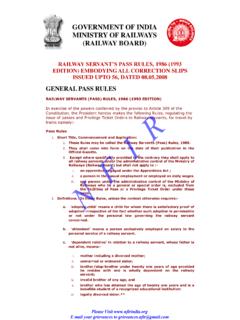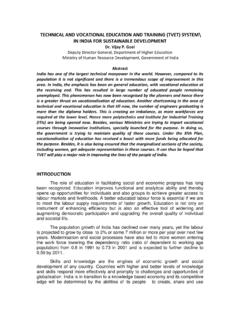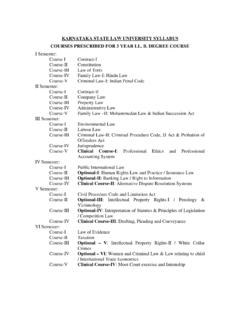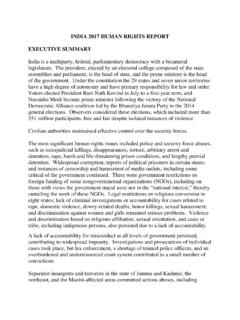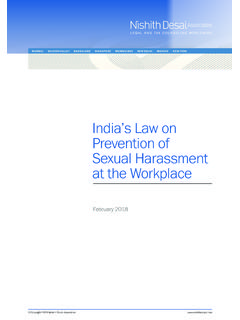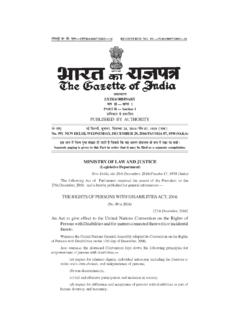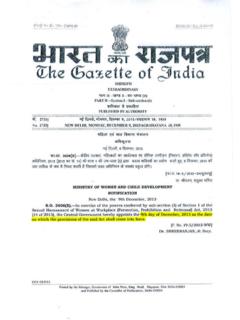Transcription of Indra Sawhney Vs Union Of India And Others
1 LAWNET India CDPage 1 Indra SawhneyVsUnion Of India And Others CASE NUMBERIAs Nos. 35-36 in WPs (C) No. 930 of 1990 EQUIVALENT CITATION2000-(001)-SCC-0168-SC2000-LIC-0 277-SC2000-AIR-0498-SC1999-(007)-SCALE-0 411-SC2000-(001)-SLT-0321-SC2000-LIC-027 7-SC1999-(006)-SLR-0001-SC1999-(009)-JT- 0557-SC1999-(010)-SUPREME-0270-SC2000-(0 01)-SRJ-0304-SC2000-(003)-SLJ-0101-SCCOR AMD P WadhwaM B ShahM Jagannadha RaoDATE OF JAGANNADHA RAO, cases in this batch raise common issues relating to the identification of "creamy layer"among the backward classes in the State of Kerala and the implementation of the law declared anddirections issued in Indra Sawhney v.
2 Union of India (1992 Supp (3) SCC 217 : 1992 SCC (L&S)Supp 1 : (1992) 22 ATC 385). The State of Kerala took time for implementation of the directions LAWNET India CDPage 2in Indra Sawhney (1992 Supp (3) SCC 217 : 1992 SCC (L&S) Supp 1 : (1992) 22 ATC 385) forappointment of a Commission for the purpose of identifying the creamy layer in the State but itfailed to appoint a Commission or to proceed with the implementation. Indra Sawhney (1992 Supp (3) SCC 217 : 1992 SCC (L&S) Supp 1 : (1992) 22 ATC 385) was decided in 1992.
3 Formore than three years the State of Kerala did not implement the judgment. This Court by its orderdated 10-7-1995 ( Indra Sawhney v. Union of India , (1999) 5 SCC 429) held (in IAs Nos. 35 and36 filed by the State for extension of time etc.) that the State of Kerala, represented by its ChiefSecretary was guilty of contempt but gave a further opportunity to the State to purge thecontempt and adjourned the matter to 11-9-1995. It was made clear that if the directions of thisCourt were not complied with, the Chief Secretary would "run the risk of being sentenced".
4 Having sought time for years to appoint a Commission, the Kerala Legislature then suddenlycame forward with the Kerala State Backward Classes (Reservation of Appointments or Posts inthe Services Under the State) Act, 1995 which, in Section 3 declared that "having regard toknown facts in existence in the State of Kerala, that there are no socially advanced sections in anybackward classes who have acquired capacity to compete with forward classes" and that thebackward classes in the State were not "adequately represented" in the services under the Stateand they would continue to be entitled to reservation under clause (4) of Article 16 of theConstitution.
5 The provisions of Section 4 continued the existing system of reservation which wasin force as per rules made in 1958 and Section 6 was incorporated as a validating section withretrospective effect. On the ground that the provisions of this Act of 1995 were discriminatoryand violative of Articles 14 and 16 of the Constitution, WP No. 699 of 1995 was filed by the NairService Society, Kerala while WP No. 727 of 1995 was filed by one K. Ramaswamy, belonging toElavami community of Kerala (a backward community) to declare the provisions of the Act asunconstitutional and violative of Articles 14 and 16 of the Constitution of India .
6 Some IAs werefiled by interveners to support one or the other of the rival groups. The Act was passed on2-9-1995 but was given retrospective effect from 2-10-1992. 2. As the State Government failed to appoint a Commission as directed in Indra Sawhney (1992 Supp (3) SCC 217 : 1992 SCC (L&S) Supp 1 : (1992) 22 ATC 385) this Court, by anelaborate order dated 4-11-1996 ( Indra Sawhney v. Union of India , (1996) 6 SCC 506 : 1996 SCC (L&S) 1477) deemed it necessary to appoint a High-Level Committee to gather thenecessary information regarding "creamy layer" and requested the Chief Justice, Kerala HighCourt, to appoint a retired Judge of the High Court to be the Chairman of the High-LevelCommittee.
7 The Chairman of the Committee, it was held, could induct not more than 4 persons asmembers from various walks of life "to identify the creamy layer among the designated backwardclasses" in the State of Kerala in the light of the ruling of this Court in Indra Sawhney (1992 Supp(3) SCC 217 : 1992 SCC (L&S) Supp 1 : (1992) 22 ATC 385) and forward its report to theSupreme Court within three months. This Court directed the State Government to extendcooperation to the above Committee. This Court also directed that the OM of the Government ofIndia dated 8-9-1993 (Ministry of Personnel, Public Grievances and Pensions) where the CentralGovernment laid down guidelines for identification of the creamy layer, be placed before theHigh-Level Committee "for use and guidance" in identifying the "creamy layer" among the other LAWNET India CDPage 3backward classes in the State of Kerala.
8 3. Accordingly, the Chief Justice of the High Court of Kerala nominated Shri Justice K. , as Chairman of the High-Level Committee. The other members of the Committee wereShri O. C. Vincent, IAS, Shri K. P. Mohammed, Advocate, Shri K. Aravindakshan Menon, retiredDistrict and Sessions Judge and Shri K. Asokan, retired Director of Public Relations. The saidCommittee, after a public notification, received evidence and gave opportunity of hearing tovarious individuals, communities etc. and submitted its Report dated 4-8-1997 to this Courtidentifying the "creamy layer" in the backward classes of Kerala State.
9 Thereafter, objections werefiled in this Court by various parties to the said Report and that is how the matter has come beforeus. 4. We do not propose just now to decide further course of action in the suo motu contemptproceedings in which the State of Kerala represented by its Chief Secretary was held guilty ofcontempt and was given time to purge the contempt. We make it clear that that issue is keptpending and the matter will be processed later, on the basis of the judgment in this case and thedirections which we propose to issue at the end of this judgment.
10 5. We have heard arguments of Shri Gopal Subramanium, learned Senior Counsel as amicuscuriae and of Shri K. K. Venugopal, learned Senior Counsel who contended that Kerala Act 16 of1995 was unconstitutional and violative of Articles 14, 16(1) and 16(4). We heard Shri , learned Senior Counsel for the State of Kerala and Shri Rajeev Dhavan, learnedSenior Counsel for the SNDP Yogam, Shri A. N. Rajan Babu, Shri E. M. S. Anam, Ms. LilyThomas and Shri V. J. Francis and Others who contended that the Act was a valid piece oflegislation. Shri K.
